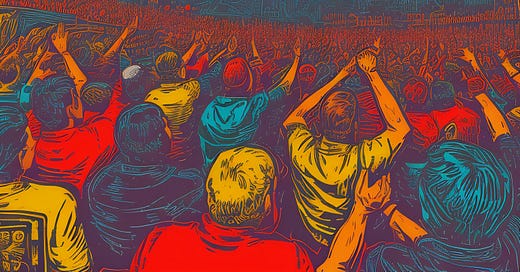Diehard Audiences
This was written during a live 2-hour writing workshop. I’m still working on it, and need to do some fact-checking and polishing. If you have comments, ideas, or reactions, feel free to jump into this
Online writers could learn from understanding the history of Coldplay and Radiohead. One band is famous, the other obscure. They started in a similar place— both were young British rock bands in the 90s, filled with white dudes and reverb. But they ended in radically different places. One’s audience is mainstream, the other’s is diehard.
Everyone knows Coldplay: they were meme’d in “40 Year Old Virgin,” they played the Super Bowl, and they ooze electric party-anthems through the radio. They’re worth $475 million. Almost no one can name a Radiohead album. If you even know a song, it’s probably “Creep,” a 1993 hit-single that the bands loathes. It’s kept alive through frat-bros with acoustic guitars who play the role of the “sensitive guy” at parties.
The bystander would say that Coldplay made it and Radiohead didn’t. But when you zoom-in and understand the arc of each band in high-detail, you’ll question which band took the better road. Radiohead makes a strong case about the Internet empowering artists. Their focus on creative evolution, paired with unique ideas in distribution, let them financially outperform the mega-stars.
Let’s time travel back to the late 1990s. Radiohead released “The Bends in ‘95, and Coldplay released their first album, “Parachutes” in 2000. I listened to each of these on repeat in the summer after my senior year. These albums appealed to the same kind of person. But from that point on, the two bands diverged.
Coldplay got more mainstream with each album, crafting arena anthems and topping CVS playlists. Radiohead took the opposite path. After their 1997 release, “OK Computer,” the band snapped. Reputable critics were arguing it to be the best album of all-time, claiming it was a prophecy of 21st century anxieties. The band couldn’t handle the expectations, and their frontman Thom Yorke had a breakdown.
For years after, the band refused to play guitars, and instead ventured into alien-sounding electronic mood-scapes. In hindsight, their next album was known as the “Biggest Left Turn in Music History.” Imagine the Egyptian Book of the Dead performed through fax machines. They resisted popular taste and followed their curiosity. Their fans, including me, were entranced with their evolution. I adored the band, but when I showed them to my friends, I’d often get, “this sounds like cats dying.”
It sounds like Coldplay played the self-promotion game and won, while Radiohead followed self-expression and lost. But let’s compare two of their albums, “Viva La Vida” (2008), and “In Rainbows” (2007), released within a year of each other. One is an international best-seller, the other unknown, but both albums were landmarks in digital distribution.
Viva La Vida, at the time, went down as the best-selling digital album ever. It was catchy, it was good, it was featured in iTunes commercials, and it made $68 million in album sales alone. It was released through Capitol Records in the US, a label that includes The Beatles, Frank Sinatra, Katy Perry, and the likes.
On the contrary, Radiohead left EMI in 2005, making In Rainbows their first independent release. They decided to publish their album on their website for free, telling their fans to “pay whatever you want.” Most people didn’t pay. But their diehard fans, the ones who followed them through their weird phases, they paid, in some cases up to $80. They sold 3 million digital copies, with an average sale of $6.
A quick glance at the numbers looks like Coldplay outsold Radiohead by 3x ($68 million vs. $18 million). But Coldplay released Viva La Vida through a record label, meaning the band’s 10% cut only comes out to $4.8 million. Radiohead kept 100% of their launch.
In Coldplay’s path towards international recognition, they sacrificed ownership of their work, creative freedom, and their reputation. Radiohead showed how a commitment towards self-expression can create a small diehard audience, one that will follow them in any direction, and one that is unlocked through the Internet. The lesson from this comparison ties to all creative mediums on the Internet. We’re undergoing an inversion in how artists think about audiences.




Very interesting.